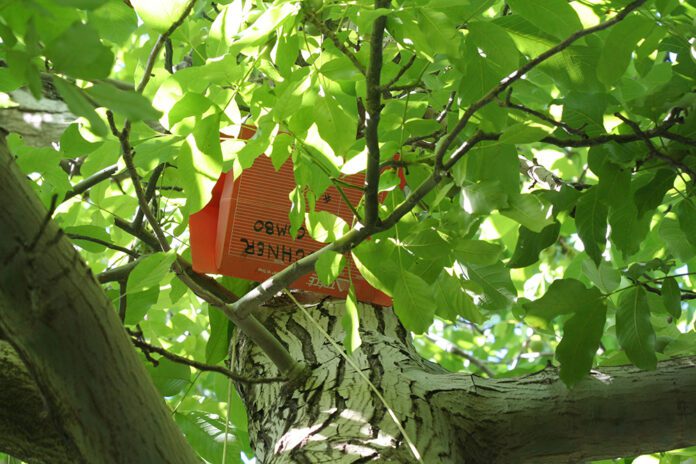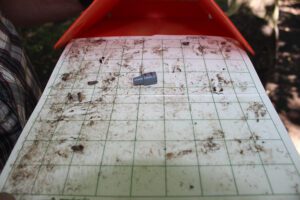
Codling moth is a major pest in walnut. It has multiple generations per year, and depending on the temperature, adults can emerge anytime from March to April.
“Last year because of the cold weather, we had a really late emergence,” said Sudan Gyawaly, UCCE IPM Advisor for Butte, Glenn, Yuba/Sutter, Colusa and Tehama counties.
Codling Moth Generations
Codling moths overwinter as mature larvae in silken cocoons under loose scales of bark or near the trunk, and the adults can be distinguished from other similar looking moths by the coppery markings on their wing tips.
In the spring, they pupate and then emerge as adults and lay eggs on the nut surface or leaves. After hatching from the egg, the tiny developing larvae bore into the nuts and feed on the kernel, and feeding can result in significant nut drop.
There may be two peaks (known as 1A and 1B) of the overwintered codling moth flights. “Sometimes there is only one peak, and sometimes there are two. If there are two peaks, the larvae resulting from the eggs that hatch from the second peak [1B] flights also feed on the nuts, but the nuts infested by larvae of the second (when present) and later flight don’t drop; they remain on the tree,” Gyawaly said, adding those nuts are rejected as unmarketable from the processor and labeled insect damaged.
Damage from codling moth provides navel orangeworm (NOW) access to the nut. NOW cannot infest walnuts until husk split, but codling moth damage provides NOW with access to the nut before husk split. NOW will infest the codling moth-infested nuts, build up in high numbers and become a problem late in the season.
NOW overwinter inside the nut, making winter sanitation very important for NOW because it removes the larvae sheltering inside the nuts. But codling moth is different from NOW and doesn’t overwinter inside nuts. Once codling moth larvae are mature, they leave the nuts and hide under the bark or around the trunk.
Mating Disruption
“Codling moth has a really good IPM program. Codling moth treatment decisions are based on current season trap captures and previous season codling moth nut damage [for 1A and 1B flight peaks] or current season nut damage [for second and later flights]. Insecticide treatments are timed when the insect is most susceptible to the applied insecticides [typically between 200 to 300 degree-days after biofix, check insecticide label for most accurate information],” Gyawaly said.
“Available management options for codling moth include insecticides, mating disruption or integration of both methods. Not all insects have mating disruption. For example, the walnut husk fly is a very serious pest, but it doesn’t have the mating disruption,” Gyawaly said.
Mating disruption is good technology that works well with codling moth, Gyawaly continued, and it can eliminate the need for spray applications in many orchards. “Mating disruption can reduce the damage to such a low level that there is no need to spray.”
Typically with mating disruption, dispensers need to be deployed in the field slightly before insect activity begins in the spring (i.e., slightly before the historic first biofix date), Gyawaly said.
Setting Traps for Mating Disruption
To monitor development and moth numbers in orchards under mating disruption, use codling moth traps with CM-DA combo lures. The CM-DA combo traps should be set mid-canopy in walnut trees, one trap every 25 acres. High counts of codling moths in these traps will help determine the need for an insecticide application.
It’s also advised to hang a smaller number of standard 1-mg traps to assess the effectiveness and longevity of the mating disruptant. Hang one trap per 50 acres or per block. The traps should be placed 6 to 8 feet high in the trees. The trap lures and bottoms should be changed at the frequency recommended by the manufacturer.
There are three types of pheromone mating disruption products available for use in walnuts:
Sprayable liquid formulations are designed to be applied with standard orchard sprayers. It contains pheromones in tiny microcapsules that release pheromones into the air and deposit it on the leaves.
Hand-applied dispensers are hung in the orchard at rates ranging from 20 to 200 units per acre. The pheromones are released into the orchard continuously over a prolonged period of time.
Aerosol dispensers are hung in the orchard at low densities, typically one unit per 1.5 to 2 acres. These mechanically dispense small amounts of pheromones into the orchard at programmed intervals.
Aerosol or plastic dispensers are placed in the upper quarter of the tree canopy before the first-flight biofix, typically mid-March in the central and southern San Joaquin Valley, and early April in the north.
Biofix is the first date that moths are consistently found in traps and sunset temperatures have reached 62 degrees F. Because biofix points vary from orchard to orchard, monitor each orchard separately to determine the biofix point for that orchard.
Sprayable pheromones are applied at or after biofix when the leaves have started growing and are partially expanded. Sprayable formulations have a short residual activity, so they need be applied at three- to four-week intervals for sustained mating disruption. Additional applications should be made shortly after the biofix of the second and third flights. When large moth numbers are present in an orchard, sprayable pheromones have been shown to reduce codling moth damage with a conventional spray program.
“The biofix date is used to time the insecticide applications, but it doesn’t make treatment decisions,” Gyawaly said.

While trap captures in monitoring traps help determine biofix date and thus the spray timing, other information like how much codling moth damage was observed the previous year and in the current season, in the tree canopy and on the orchard floor is necessary for determining the need for treatment, he continued.
“If there was less than 3% damage last year and the trap capture is lower than two moths/trap/night, that means there is no need to spray until the second flight peak [1B]. However, if there was more than 3% damage last year and the trap capture is more than two moths/trap/night, treatments are needed for both 1A and 1B flight larvae. Similar treatment decisions based on current season nut damage are available for later generations of codling moth as well,” Gyawaly said.
Early maturing walnut varieties are more susceptible to codling moth because they offer feeding opportunities when the first flight appears in March and April. With early varieties, larvae can chew into poorly sealed nuts. Later varieties can also sustain larval feeding damage.
Chemical Sprays
Codling moth has several chemicals available that includes reduced risk and growth regulator insecticides. Many pesticides that work for NOW also work for codling moth.
Codling moths has several insecticides available, and it is important to rotate chemistries to reduce the risk of resistance from building. “In IPM, we always emphasize rotating the chemistries. If you look at the IPM programs and the insecticide labels for how many sprays of the same insecticide can be applied in a season or in a generation closely, they always highlight the importance of rotating between the chemistries,” Gyawaly said.















